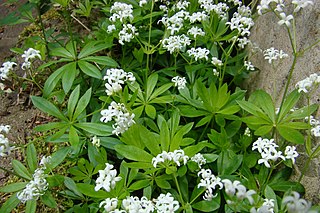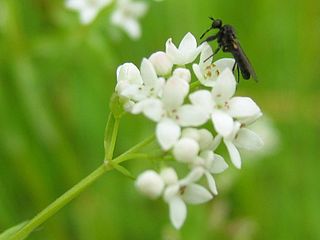
Galium odoratum, the sweetscented bedstraw, is a flowering perennial plant in the family Rubiaceae, native to much of Europe from Spain and Ireland to Russia, as well as Western Siberia, Turkey, Iran, the Caucasus, China and Japan. It is also sparingly naturalized in scattered locations in the United States and Canada. It is widely cultivated for its flowers and its sweet-smelling foliage.

Galium verum is a herbaceous perennial plant of the family Rubiaceae. It is widespread across most of Europe, North Africa, and temperate Asia from Palestine, Lebanon and Turkey to Japan and Kamchatka. It is naturalized in Tasmania, New Zealand, Canada, and the northern half of the United States. It is considered a noxious weed in some places.

Galium album, the white bedstraw or hedge bedstraw, is a herbaceous annual plant of the family Rubiaceae.

Galium mollugo, common name hedge bedstraw or false baby's breath, is a herbaceous annual plant of the family Rubiaceae. It shares the name hedge bedstraw with the related European species, Galium album.
NVC community CG2 is one of the calcicolous grassland communities in the British National Vegetation Classification system. It is one of three short-sward communities associated with heavy grazing, within the lowland calcicolous grassland group, and is regarded as "typical" chalk grassland.

Barnsley Warren is a 61.3-hectare (151-acre) biological Site of Special Scientific Interest in Gloucestershire, notified in 1954 and renotified in 1984. The site is also a Nature Conservation Review site. It lies in a steep-sided dry valley, east of the A429, northeast of Cirencester in the Cotswolds. The site is listed in the 'Cotswold District' Local Plan 2001-2011 as a Key Wildlife Site (KWS).

Galium palustre, the common marsh bedstraw or simply marsh-bedstraw, is a herbaceous annual plant of the family Rubiaceae. This plant is widely distributed, native to virtually every country in Europe, plus Morocco, the Azores, Turkey, Turkmenistan, Western Siberia, Greenland, eastern Canada, St. Pierre & Miquelon, and parts of the United States. The species is classified as a noxious weed in New York, Pennsylvania, Massachusetts, Connecticut, Vermont and New Hampshire. It is considered naturalized in Kamchatka, Australia, New Zealand and Argentina.

Galium saxatile or heath bedstraw is a plant species of the genus Galium. It is related to cleavers.

Galium sylvaticum, commonly known as Scotch mist or wood bedstraw, is a plant species of the genus Rubiaceae. Its genus name, Galium, is derived from the Greek word for "milk," apparently because some species have been used to curdle milk.

Comandra is a monotypic genus containing the single species Comandra umbellata. Its common names include bastard toadflax, umbellate bastard toadflax, and common comandra. The plant has a disjunct distribution; its four subspecies occur in North America and the Mediterranean.

Thesium is a genus of flowering plants in the family Santalaceae. It is particularly well represented in South Africa.

Galium divaricatum is a species of flowering plant in the coffee family known by the common name Lamarck's bedstraw.

Galium multiflorum is a species of flowering plant in the coffee family known by the common names Kellogg's bedstraw, shrubby bedstraw, and many-flowered bedstraw.

Galium tricornutum is a species of flowering plant in the coffee family known by the common names rough corn bedstraw, roughfruit corn bedstraw, and corn cleavers. It is widespread across most of Europe plus northern Africa and southern Asia, from Norway, Portugal and Morocco to China. It is also naturalized in Australia, the Canary Islands, Mauritius, Madeira, Réunion, Brazil, Argentina, and scattered locales in North America.
NVC community CG5 is one of the calcicolous grassland communities in the British National Vegetation Classification system. It is one of four communities of rank, tussocky grassland associated with low levels of grazing, within the lowland calcicolous grassland group.
Galium cliftonsmithii is a species of flowering plant in the coffee family known by the common name Santa Barbara bedstraw. It is endemic to the coastal mountain ranges of California from Monterey to Los Angeles Counties. This is a perennial herb with slender, prickly climbing stems 30 to 60 centimeters long. The stems have whorls of four oval-shaped, pointed leaves tipped with hairs. The plant is dioecious, with individuals bearing either male or female flowers. Both types of flowers are yellowish and borne in small clusters. This plant was named for Clifton F. Smith, head botanist at the Santa Barbara Botanic Garden in 1958.
Galium murale is a species of flowering plant in the coffee family known by the common names small goosegrass, yellow wall bedstraw and tiny bedstraw. It is native to the Mediterranean Basin of southern Europe and northern Africa, and the Middle East from Turkey and the Caucasus east to Iran and south to Saudi Arabia and Somalia. It is also considered native to the Canary Islands, Madeira and the Azores. It is naturalised in Australia, New Zealand, Argentina, Chile and California.

Hypericum humifusum is a prostrate flowering plant in the genus Hypericum commonly known as trailing St John's-wort. It is found in Western Europe.

Galium antarcticum, commonly known as Antarctic bedstraw or subantarctic bedstraw, is a species of flowering plant in the coffee family. It has a largely subantarctic range.

Galium verrucosum, common name warty bedstraw (US) or southern cleavers (UK), is a species of plants in the Rubiaceae. The epithet "verrucosum" means "warty" in reference to the numerous bumps on the mature fruit. It is native to the Mediterranean Basin from Portugal and Morocco to Turkey and Palestine. It is reportedly naturalized in Great Britain, Central Europe, the Canary Islands, Madeira, and Wayne County (Michigan).
















